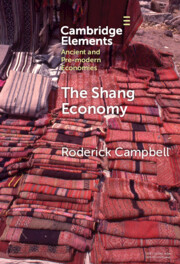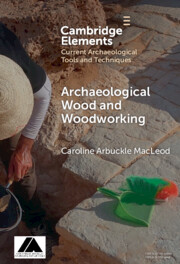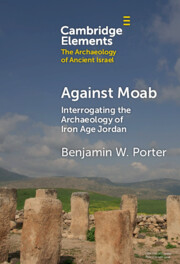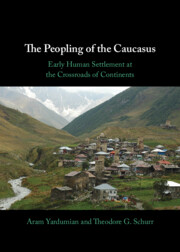Refine search
Actions for selected content:
495 results

The Archaeology of the Cyclades in the Roman and Late Antique Periods
- Globalization, Christianization and Resilience
-
- Published online:
- 23 October 2025
- Print publication:
- 06 November 2025
A look at intercultural archaeology from the Colombian Caribbean
-
- Journal:
- Archaeological Dialogues / Volume 31 / Issue 1 / June 2024
- Published online by Cambridge University Press:
- 23 October 2025, pp. 31-34
-
- Article
-
- You have access
- Open access
- HTML
- Export citation
New prehistoric occupations identified in the eastern Iberian Plateau
-
- Journal:
- Antiquity , First View
- Published online by Cambridge University Press:
- 23 October 2025, pp. 1-7
-
- Article
-
- You have access
- Open access
- HTML
- Export citation
The Apostle Sculptures of Yorkshire, St Wilfrid’s Episcopal Mission and his Cult: Aspects of Ecclesiastical Conflicts in Northumbria from the Late Seventh to Early Ninth Centuries
-
- Journal:
- Early Medieval England and its Neighbours / Volume 51 / 2025
- Published online by Cambridge University Press:
- 17 October 2025, e14
-
- Article
-
- You have access
- Open access
- HTML
- Export citation
SILCHESTER INSULA ix: THE EXCAVATIONS IN PERSPECTIVE
-
- Journal:
- The Antiquaries Journal , First View
- Published online by Cambridge University Press:
- 16 October 2025, pp. 1-14
-
- Article
-
- You have access
- Open access
- HTML
- Export citation
Documenting the profession: Recording historic access and retention issues for women in UK archaeology
-
- Journal:
- Archaeological Dialogues / Volume 31 / Issue 1 / June 2024
- Published online by Cambridge University Press:
- 26 September 2025, pp. 76-100
-
- Article
-
- You have access
- Open access
- HTML
- Export citation
Chapter Six - Multidisciplinary Means of Addressing Pastoral Ecologies and Economies in the Past
-
- Book:
- The Archaeology of Pastoralism, Mobility, and Society
- Published online:
- 04 September 2025
- Print publication:
- 18 September 2025, pp 258-272
-
- Chapter
- Export citation
Chapter One - From Orientalist Tropes to aDNA and Isotopes
-
- Book:
- The Archaeology of Pastoralism, Mobility, and Society
- Published online:
- 04 September 2025
- Print publication:
- 18 September 2025, pp 20-55
-
- Chapter
- Export citation
Chapter Seven - Social and Political Perspectives on Ancient and Historical Pastoralism
-
- Book:
- The Archaeology of Pastoralism, Mobility, and Society
- Published online:
- 04 September 2025
- Print publication:
- 18 September 2025, pp 273-318
-
- Chapter
- Export citation
Archaeology of a Mass Murder: The Concealed Gravesite of Jama pod Macesnovo gorico in Slovenia
-
- Journal:
- European Journal of Archaeology , First View
- Published online by Cambridge University Press:
- 10 September 2025, pp. 1-21
-
- Article
-
- You have access
- Open access
- HTML
- Export citation
Potential refugia on the Tibetan Plateau during the last glacial maximum
-
- Journal:
- Quaternary Research , First View
- Published online by Cambridge University Press:
- 05 September 2025, pp. 1-11
-
- Article
-
- You have access
- Open access
- HTML
- Export citation
Confronting Archaeology’s “Gray Zones”
-
- Journal:
- American Antiquity / Volume 90 / Issue 3 / July 2025
- Published online by Cambridge University Press:
- 09 September 2025, pp. 555-572
- Print publication:
- July 2025
-
- Article
-
- You have access
- Open access
- HTML
- Export citation
Reservoir Effects from Shells of Tell Abraq, Sharjah Emirate, UAE
-
- Journal:
- Radiocarbon / Volume 67 / Issue 3 / June 2025
- Published online by Cambridge University Press:
- 19 May 2025, pp. 600-612
- Print publication:
- June 2025
-
- Article
- Export citation
Spain: No Country for Furtive Detectorism
-
- Journal:
- International Journal of Cultural Property / Volume 32 / Issue 2 / May 2025
- Published online by Cambridge University Press:
- 16 April 2025, pp. 132-148
-
- Article
-
- You have access
- Open access
- HTML
- Export citation

The Shang Economy
-
- Published online:
- 27 March 2025
- Print publication:
- 10 April 2025
-
- Element
- Export citation

Archaeological Wood and Woodworking
-
- Published online:
- 14 March 2025
- Print publication:
- 10 April 2025
-
- Element
- Export citation

Against Moab
- Interrogating the Archaeology of Iron Age Jordan
-
- Published online:
- 14 March 2025
- Print publication:
- 10 April 2025
-
- Element
-
- You have access
- Open access
- HTML
- Export citation
Chapter Nine - A Synthetic View of the Peopling of the Caucasus
-
- Book:
- The Peopling of the Caucasus
- Published online:
- 21 January 2025
- Print publication:
- 23 January 2025, pp 202-208
-
- Chapter
- Export citation
Chapter Ten - Further Research into the Peopling of the Caucasus
-
- Book:
- The Peopling of the Caucasus
- Published online:
- 21 January 2025
- Print publication:
- 23 January 2025, pp 209-216
-
- Chapter
- Export citation

The Peopling of the Caucasus
- Early Human Settlement at the Crossroads of Continents
-
- Published online:
- 21 January 2025
- Print publication:
- 23 January 2025
